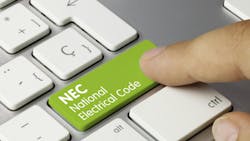Understanding General Requirements of the NEC, Part 5
Article 110 provides general requirements for all installations. Continuing on from where we left off with Sec. 110.3, the voltage rating of electrical equipment can’t be less than the nominal voltage of the circuit it’s connected to [Sec. 110.4]. You can’t, for example, use a 120V circuit breaker for a 277V lighting circuit.
Conductors used to carry current must be copper, aluminum, or copper-clad aluminum unless otherwise provided for in the Code [Sec. 110.5]. Where the material is not specified, the sizes given in the Code apply to copper conductors. Aluminum ones would necessarily be larger for the same application, you must change the size accordingly. Conductor sizes are expressed in American Wire Guage (AWG) or circular mils [Sec. 110.6]. In trade jargon, we often say something like “number 10 conductor” and that means the conductor is 10 AWG. We never refer to a conductor in terms of amperage, so you would not refer to a conductor used for 120V house wiring as a “20A conductor.”
Completed wiring must be free of electrical shorts, ground faults, or any connection to ground other than required or permitted elsewhere in the Code [Sec. 110.7]. This doesn’t mean simply by design — it also means due to workmanship. An easy way to violate this requirement and possibly not know you violated it is to drill a hole in a cabinet and pull conductors through it without installing a grommet or fitting in the drilled opening. It is not acceptable to wrap the conductor in phasing tape in lieu of installing a fitting or grommet, except under specific conditions such as temporary restoration of power.
Always debur any cut or hole, and always use a fitting or grommet to protect the conductors. To get a cleaner hole to start with, use a hole punch where practical. While a hole punch set is expensive, using a hole punch can save time, improve accuracy, and reduce cleanup challenges.
The Code includes only those wiring methods that are recognized as suitable [Sec. 110.8]. And, though not stated here, it includes all suitable wiring methods. Which means if a wiring method isn’t included in the Code it isn’t suitable, barring some kind of special permission from the AHJ. You can use any of the recognized wiring methods in any type of building, occupancy, or premises wiring system except as otherwise provided in the Code.
Equipment intended to interrupt current at fault levels must have an interrupt rating (at nominal system voltage) at least equal to the available fault current at the line terminals of the equipment [Sec. 110.9]. Equipment intended to interrupt current at other than fault levels must have an interrupting rating (at nominal circuit voltage) at least equal to the current being interrupted. What does this mean in practical terms? There are standard methods for calculating the fault current at a given point in an electrical system. Where you intend to interrupt the fault current, for example at the secondary of a transformer, you must know how much such current would be available. But you don’t need to know the available fault current for the branch circuits supplied by that transformer because you aren’t interrupting the available fault current supplied by the transformer; you are merely opening that circuit.
About the Author

Mark Lamendola
Mark is an expert in maintenance management, having racked up an impressive track record during his time working in the field. He also has extensive knowledge of, and practical expertise with, the National Electrical Code (NEC). Through his consulting business, he provides articles and training materials on electrical topics, specializing in making difficult subjects easy to understand and focusing on the practical aspects of electrical work.
Prior to starting his own business, Mark served as the Technical Editor on EC&M for six years, worked three years in nuclear maintenance, six years as a contract project engineer/project manager, three years as a systems engineer, and three years in plant maintenance management.
Mark earned an AAS degree from Rock Valley College, a BSEET from Columbia Pacific University, and an MBA from Lake Erie College. He’s also completed several related certifications over the years and even was formerly licensed as a Master Electrician. He is a Senior Member of the IEEE and past Chairman of the Kansas City Chapters of both the IEEE and the IEEE Computer Society. Mark also served as the program director for, a board member of, and webmaster of, the Midwest Chapter of the 7x24 Exchange. He has also held memberships with the following organizations: NETA, NFPA, International Association of Webmasters, and Institute of Certified Professional Managers.
